Role of Snowpack-Hydrometeorological Sensors for Hydrogeological System Comprehension inside an Alpine Closed-Basin
Abstract
:1. Introduction
2. Materials and Methods
2.1. The Mascognaz Spring System Monitoring
2.2. Snowpack-Weather Station (SWS) Setup
2.2.1. Corr-Tek Meteorological Sensors
2.2.2. Sommer GmbH & Co. KG Snowpack Sensors
2.3. Hydrometric Equipment
3. Results
4. Discussion
5. Conclusions
Author Contributions
Funding
Institutional Review Board Statement
Informed Consent Statement
Data Availability Statement
Acknowledgments
Conflicts of Interest
References
- IGRAC (International Groundwater Resources Assessment Centre). Transboundary Aquifers of the World [Map], 2021 ed., Scale 1:50,000,000; IGRAC: Delft, The Netherlands, 2021. [Google Scholar]
- Boretti, A.; Rosa, L. Reassessing the projections of the world water development report. NPJ Clean Water 2019, 2, 15. [Google Scholar] [CrossRef]
- Unesco. Leaving No One Behind, The United Nations World Water Development Report 2019; United Nations Educational, Scientific and Cultural Organization: Paris, France, 2019. [Google Scholar]
- Lo Russo, S.; Amanzio, G.; Ghione, R.; De Maio, M. Recession Hydrographs and Time Series Analysis of Springs Monitoring Data: Application on Porous and Shallow Aquifers in Mountain Areas (Aosta Valley). Environ. Earth Sci. 2015, 73, 7415–7434. [Google Scholar] [CrossRef]
- Amanzio, G.; Marchionatti, F.; Lavy, M.; Ghione, R.; De Maio, M. Springs monitoring data analysis with a frequency and time domain approach: The case study of Mascognaz spring (Aosta Valley). Geoing. Ambient. E Min. 2016, 147, 5–12. [Google Scholar]
- Lo Russo, S.; Suozzi, E.; Gizzi, M.; Taddia, G. SOURCE: A Semi-Automatic Tool for Spring-Monitoring Data Analysis and Aquifer Characterisation. Environ. Earth Sci. 2021, 80, 1–13. [Google Scholar] [CrossRef]
- Wu, W.Y.; Lo, M.H.; Wada, Y.; Famiglietti, J.S.; Reager, J.T.; Yeh, P.J.F.; Ducharne, A.; Yang, Z.L. Divergent Effects of Climate Change on Future Groundwater Availability in Key Mid-Latitude Aquifers. Nat. Commun. 2020, 11, 1–9. [Google Scholar] [CrossRef]
- Gizzi, M.; Mondani, M.; Taddia, G.; Suozzi, E.; Lo Russo, S. Aosta Valley Mountain Springs: A Preliminary Analysis for Understanding Variations in Water Resource Availability under Climate Change. Water 2022, 14, 1004. [Google Scholar] [CrossRef]
- Carvalho-Santos, C.; Monteiro, A.T.; Azevedo, J.C.; Honrado, J.P.; Nunes, J.P. Climate Change Impacts on Water Resources and Reservoir Management: Uncertainty and Adaptation for a Mountain Catchment in Northeast Portugal. Water Resour. Manag. 2017, 31, 3355–3370. [Google Scholar] [CrossRef]
- Amanambu, A.C.; Obarein, O.A.; Mossa, J.; Li, L.; Ayeni, S.S.; Balogun, O.; Oyebamiji, A.; Ochege, F.U. Groundwater System and Climate Change: Present Status and Future Considerations. J. Hydrol. 2020, 589, 125163. [Google Scholar] [CrossRef]
- Berg, N.; Hall, A. Increased Interannual Precipitation Extremes over California under Climate Change. J. Clim. 2015, 28, 6324–6334. [Google Scholar] [CrossRef]
- Mo, C.; Ruan, Y.; He, J.; Jin, J.L.; Liu, P.; Sun, G. Frequency Analysis of Precipitation Extremes under Climate Change. Int. J. Climatol. 2019, 39, 1373–1387. [Google Scholar] [CrossRef]
- Szwed, M. Variability of Precipitation in Poland under Climate Change. Theor. Appl. Climatol. 2019, 135, 1003–1015. [Google Scholar] [CrossRef] [Green Version]
- Barnett, T.P.; Adam, J.C.; Lettenmaier, D.P. Potential Impacts of a Warming Climate on Water Availability in Snow-Dominated Regions. Nature 2005, 438, 303–309. [Google Scholar] [CrossRef]
- Clow, D.W. Changes in the Timing of Snowmelt and Streamflow in Colorado: A Response to Recent Warming. J. Clim. 2010, 23, 2293–2306. [Google Scholar] [CrossRef]
- Jepsen, S.M.; Molotch, N.P.; Williams, M.W.; Rittger, K.E.; Sickman, J.O. Interannual Variability of Snowmelt in the Sierra Nevada and Rocky Mountains, United States: Examples from Two Alpine Watersheds. Water Resour. Res. 2012, 48, W02529. [Google Scholar] [CrossRef]
- Wu, X.; Che, T.; Li, X.; Wang, N.; Yang, X. Slower Snowmelt in Spring Along With Climate Warming Across the Northern Hemisphere. Geophys. Res. Lett. 2018, 45, 12331–12339. [Google Scholar] [CrossRef]
- Jódar, J.; González-Ramón, A.; Martos-Rosillo, S.; Heredia, J.; Herrera, C.; Urrutia, J.; Caballero, Y.; Zabaleta, A.; Antigüedad, I.; Custodio, E.; et al. Snowmelt as a Determinant Factor in the Hydrogeological Behaviour of High Mountain Karst Aquifers: The Garcés Karst System, Central Pyrenees (Spain). Sci. Total Environ. 2020, 748, 141363. [Google Scholar] [CrossRef]
- Thibert, E.; Dkengne Sielenou, P.; Vionnet, V.; Eckert, N.; Vincent, C. Causes of Glacier Melt Extremes in the Alps Since 1949. Geophys. Res. Lett. 2018, 45, 817–825. [Google Scholar] [CrossRef]
- Colucci, R.R.; Guglielmin, M. Climate Change and Rapid Ice Melt: Suggestions from Abrupt Permafrost Degradation and Ice Melting in an Alpine Ice Cave. Prog. Phys. Geogr. 2019, 43, 561–573. [Google Scholar] [CrossRef]
- Mohammadi, Z.; Shoja, A. Effect of Annual Rainfall Amount on Characteristics of Karst Spring Hydrograph. Carbonates Evaporites 2014, 29, 279–289. [Google Scholar] [CrossRef]
- Kodali, R.K.; Mandal, S. IoT Based Weather Station. In Proceedings of the 2016 International Conference on Control, Instrumentation, Communication and Computational Technologies (ICCICCT), Kumaracoil, India, 16–17 December 2016; pp. 680–683. [Google Scholar]
- Dombrowski, O.; Franssen, H.H.; Brogi, C. Performance of the ATMOS41 All-in-One Weather Station for Weather Monitoring. Sensors 2021, 21, 741. [Google Scholar] [CrossRef]
- Attah, D.A.; Bankkole, G.M. Time Series Analysis Model for Annual Rainfall Data in Lower Kaduna Catchment Kaduna, Nigeria. Glob. J. Res. Eng. 2012, 2, 82–87. [Google Scholar]
- Olatayo, T.O.; Taiwo, A.I. Statistical Modelling and Prediction of Rainfall Time Series Data. Glob. J. Comuter Sci. Technol. 2014, 14, 1–10. [Google Scholar]
- Zhang, Y.; Yu, Y.; Peng, M.; Meng, R.; Hu, K.; Yu, C. Temporal and Seasonal Variations of Mortality Burden Associated with Hourly Temperature Variability: A Nationwide Investigation in England and Wales. Environ. Int. 2018, 115, 325–333. [Google Scholar] [CrossRef] [PubMed]
- Harris, I.; Osborn, T.J.; Jones, P.; Lister, D. Version 4 of the CRU TS Monthly High-Resolution Gridded Multivariate Climate Dataset. Sci. Data 2020, 7, 109. [Google Scholar] [CrossRef]
- Cerino Abdin, E.; Taddia, G.; Gizzi, M.; Lo Russo, S. Reliability of Spring Recession Curve Analysis as a Function of the Temporal Resolution of the Monitoring Dataset. Environ. Earth Sci. 2021, 80, 249. [Google Scholar] [CrossRef]
- Lucianetti, G.; Penna, D.; Mastrorillo, L.; Mazza, R. The role of snowmelt on the spatio-temporal variability of spring recharge in a dolomitic mountain group, Italian Alps. Water 2020, 12, 2256. [Google Scholar] [CrossRef]
- Brkić, Ž.; Kuhta, M.; Hunjak, T. Groundwater flow mechanism in the well-developed karst aquifer system in the western Croatia: Insights from spring discharge and water isotopes. Catena 2018, 161, 14–26. [Google Scholar] [CrossRef]
- Diodato, N.; Guerriero, L.; Fiorillo, F.; Esposito, L.; Revellino, P.; Grelle, G.; Guadagno, F.M. Predicting monthly spring discharges using a simple statistical model. Water Resour. Manag. 2014, 28, 969–978. [Google Scholar] [CrossRef]
- Negi, G.; Joshi, V. Rainfall and spring discharge patterns in two small drainage catchments in the Western Himalayan Mountains, India. Environmentalist 2004, 24, 19–28. [Google Scholar] [CrossRef]
- Jan, F.; Min-Allah, N.; Saeed, S.; Iqbal, S.Z.; Ahmed, R. IoT-Based Solutions to Monitor Water Level, Leakage, and Control for Smart Water Tanks. Water 2022, 14, 309. [Google Scholar] [CrossRef]
- Jan, F.; Min-Allah, N.; Düştegör, D. IoT based smart water quality monitoring: Recent techniques, trends and challenges for domestic applications. Water 2021, 13, 1729. [Google Scholar] [CrossRef]
- Crepaldi, S.; De Maio, M.; Suozzi, E. Preliminary Study on the Snow-Melt for the Groundwater Recharge Estimated by an Advanced Meteorological Station. Eng. Geol. Soc. Territ. 2015, 1, 109–112. [Google Scholar]
- Varhola, A.; Wawerla, J.; Weiler, M.; Coops, N.C.; Bewley, D.; Alila, Y. A New Low-Cost, Stand-Alone Sensor System for Snow Monitoring. J. Atmos. Ocean. Technol. 2010, 27, 1973–1978. [Google Scholar] [CrossRef]
- Fiorillo, F.; Doglioni, A. The Relation between Karst Spring Discharge and Rainfall by Cross-Correlation Analysis (Campania, Southern Italy). Hydrogeol. J. 2010, 18, 1881–1895. [Google Scholar] [CrossRef]
- Swamee, P.K. Generalized rectangular weir equations. J. Hydraul. Eng. 1988, 114, 945–949. [Google Scholar] [CrossRef]
- Dirmhirn, I.; Eaton, F.D. Some Characteristics of the Albedo of Snow. J. Appl. Meteorol. Climatol. 1975, 14, 375–379. [Google Scholar] [CrossRef]
- López-Moreno, J.I.; Fassnacht, S.R.; Heath, J.T.; Musselman, K.N.; Revuelto, J.; Latron, J.; Morán-Tejeda, E.; Jonas, T. Small Scale Spatial Variability of Snow Density and Depth over Complex Alpine Terrain: Implications for Estimating Snow Water Equivalent. Adv. Water Resour. 2013, 55, 40–52. [Google Scholar] [CrossRef]
- Zuecco, G.; Carturan, L.; De Blasi, F.; Seppi, R.; Zanoner, T.; Penna, D.; Borga, M.; Carton, A.; Dalla Fontana, G. Understanding Hydrological Processes in Glacierized Catchments: Evidence and Implications of Highly Variable Isotopic and Electrical Conductivity Data. Hydrol. Process. 2019, 33, 816–832. [Google Scholar] [CrossRef]
- Pandey, C.K.; Katiyar, A.K. Solar Radiation: Models and Measurement Techniques. J. Energy 2013, 2013, 305207. [Google Scholar] [CrossRef] [Green Version]
- Kresic, N.; Bonacci, O. Spring Discharge Hydrograph. In Groundwater Hydrology of Springs; Elsevier: Amsterdam, The Netherlands, 2010; pp. 129–163. [Google Scholar]
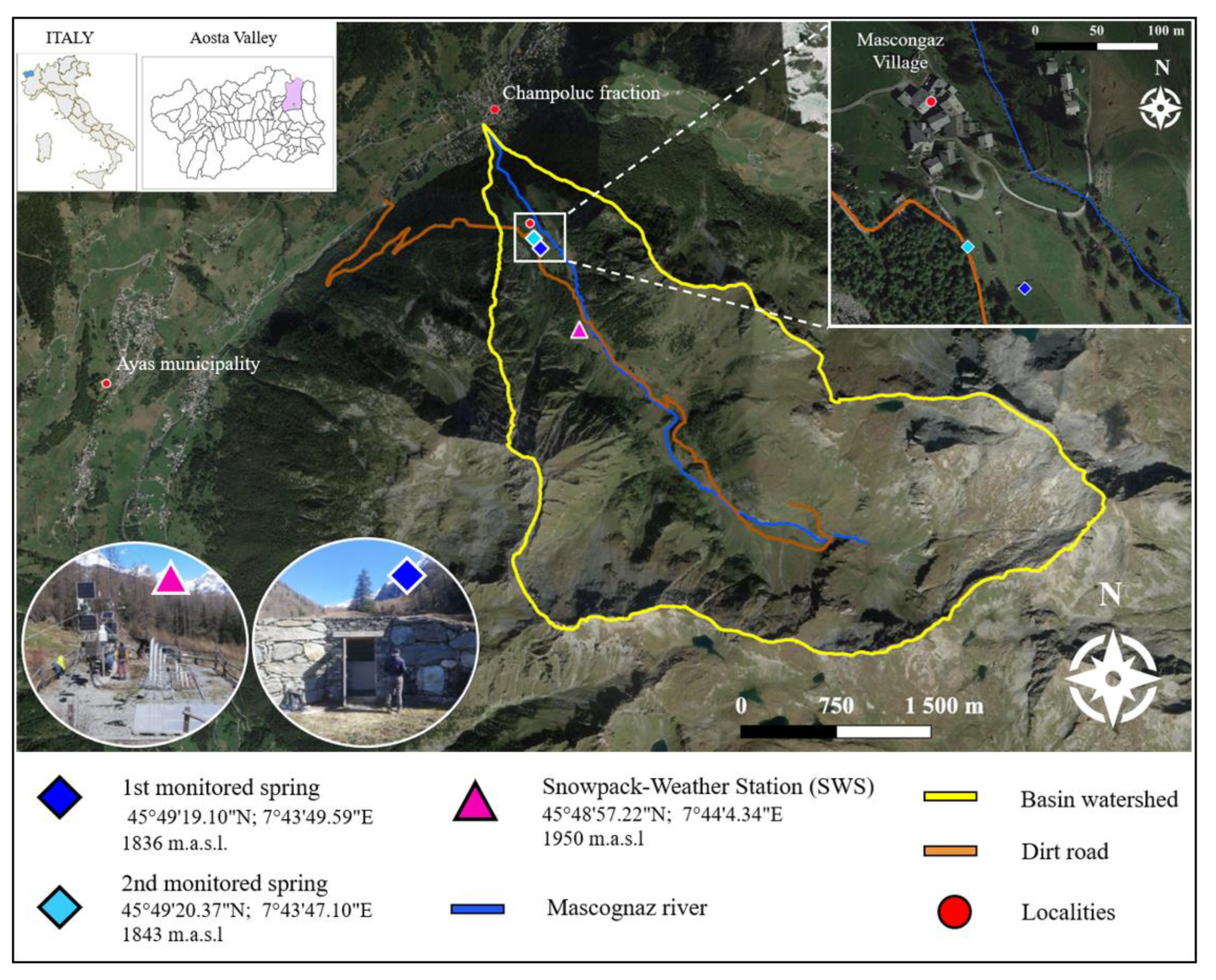
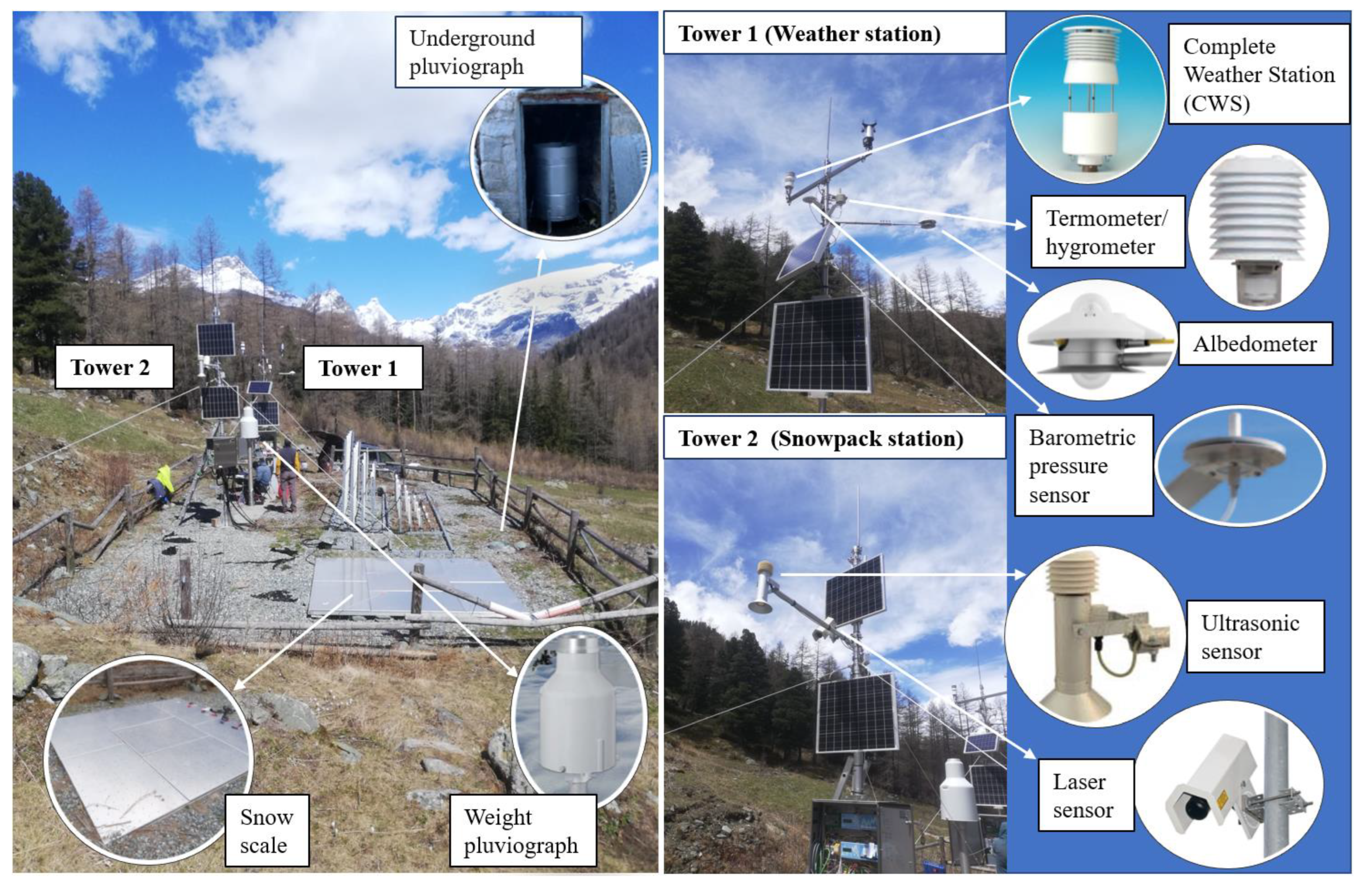
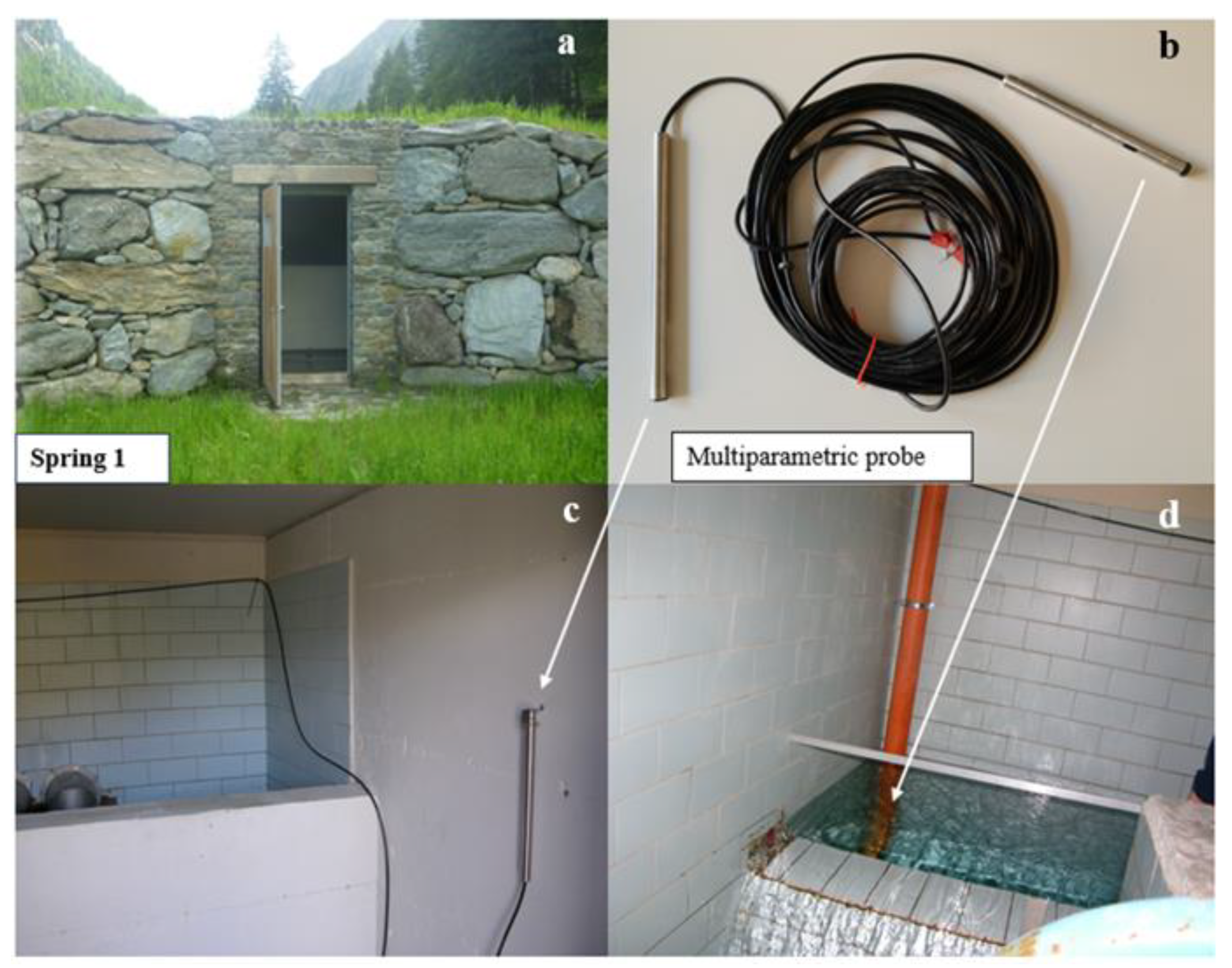
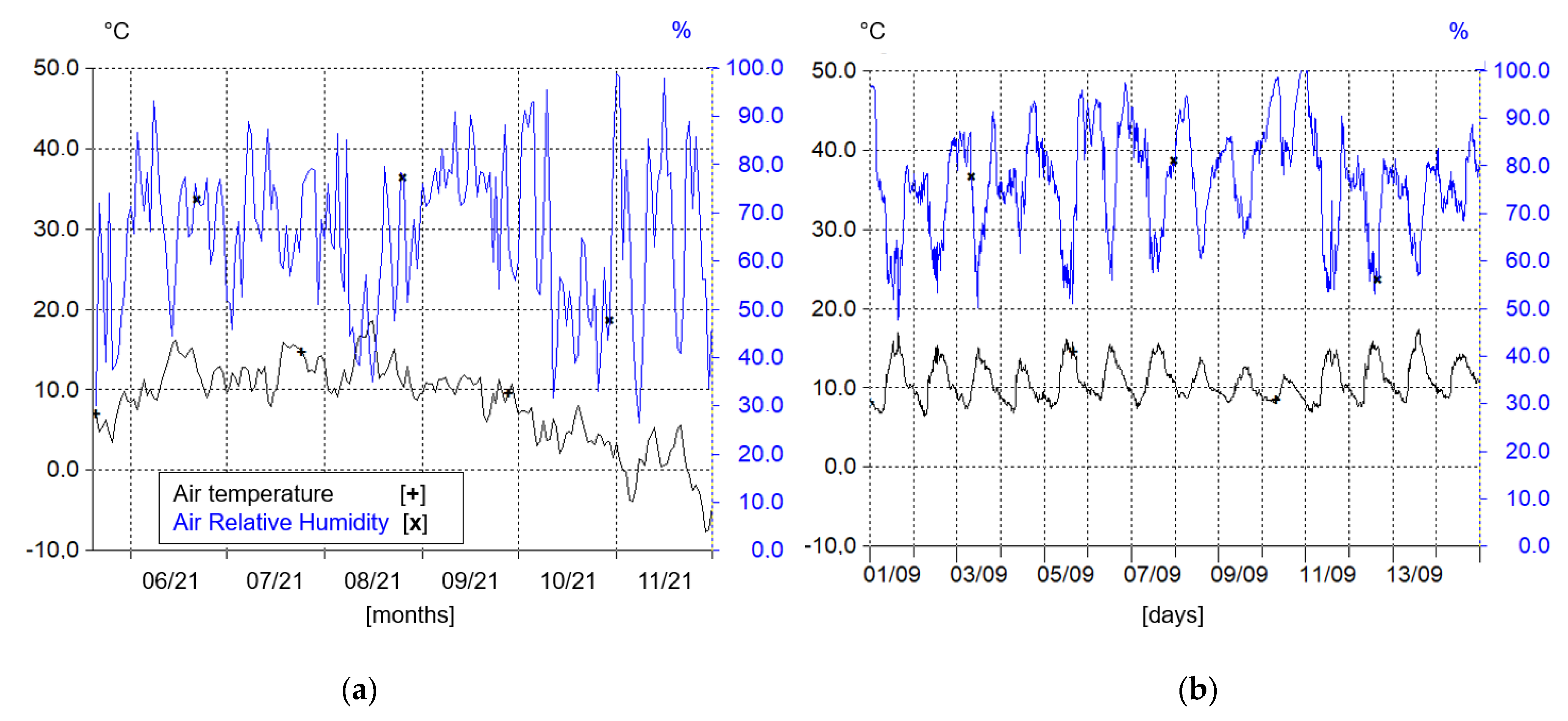
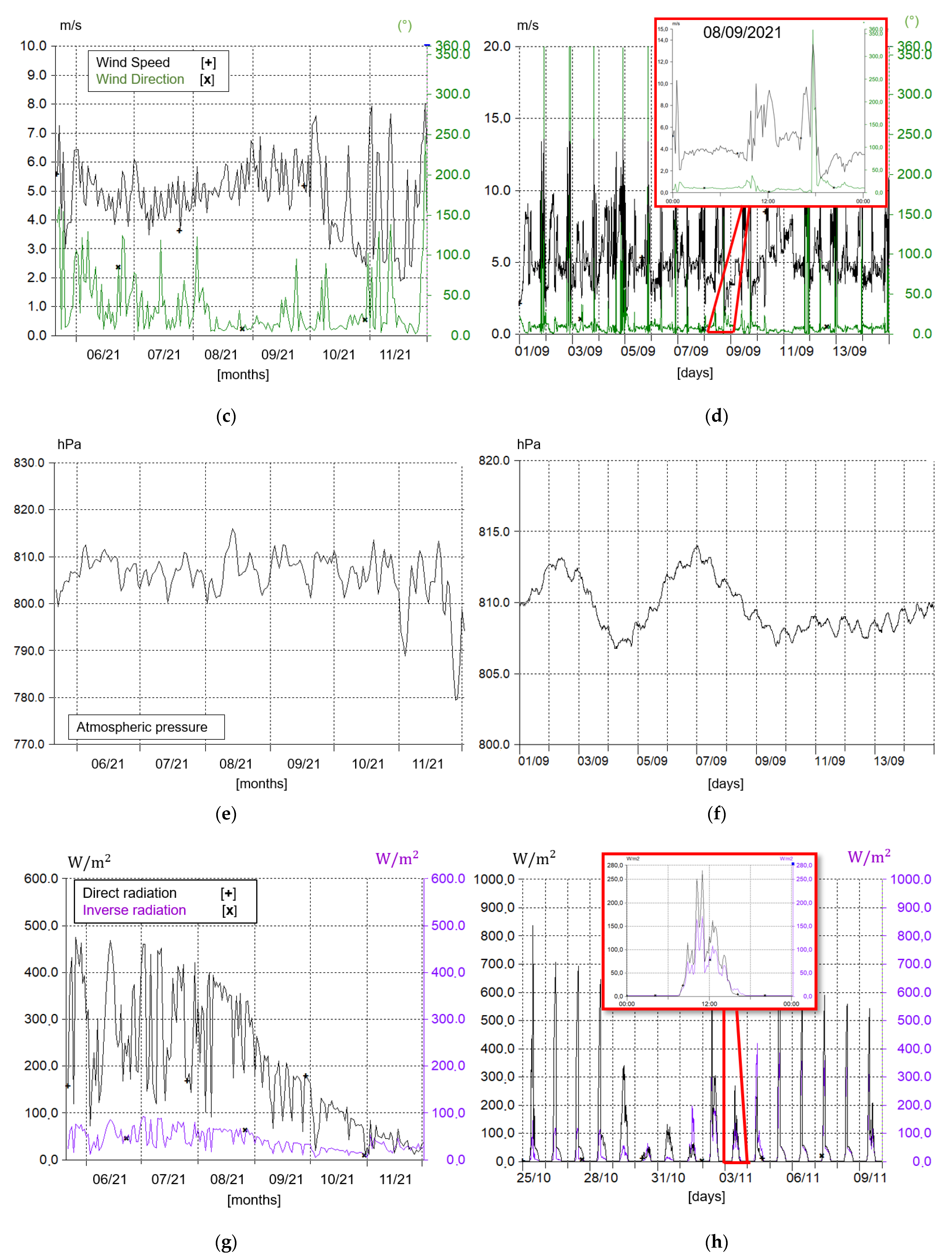

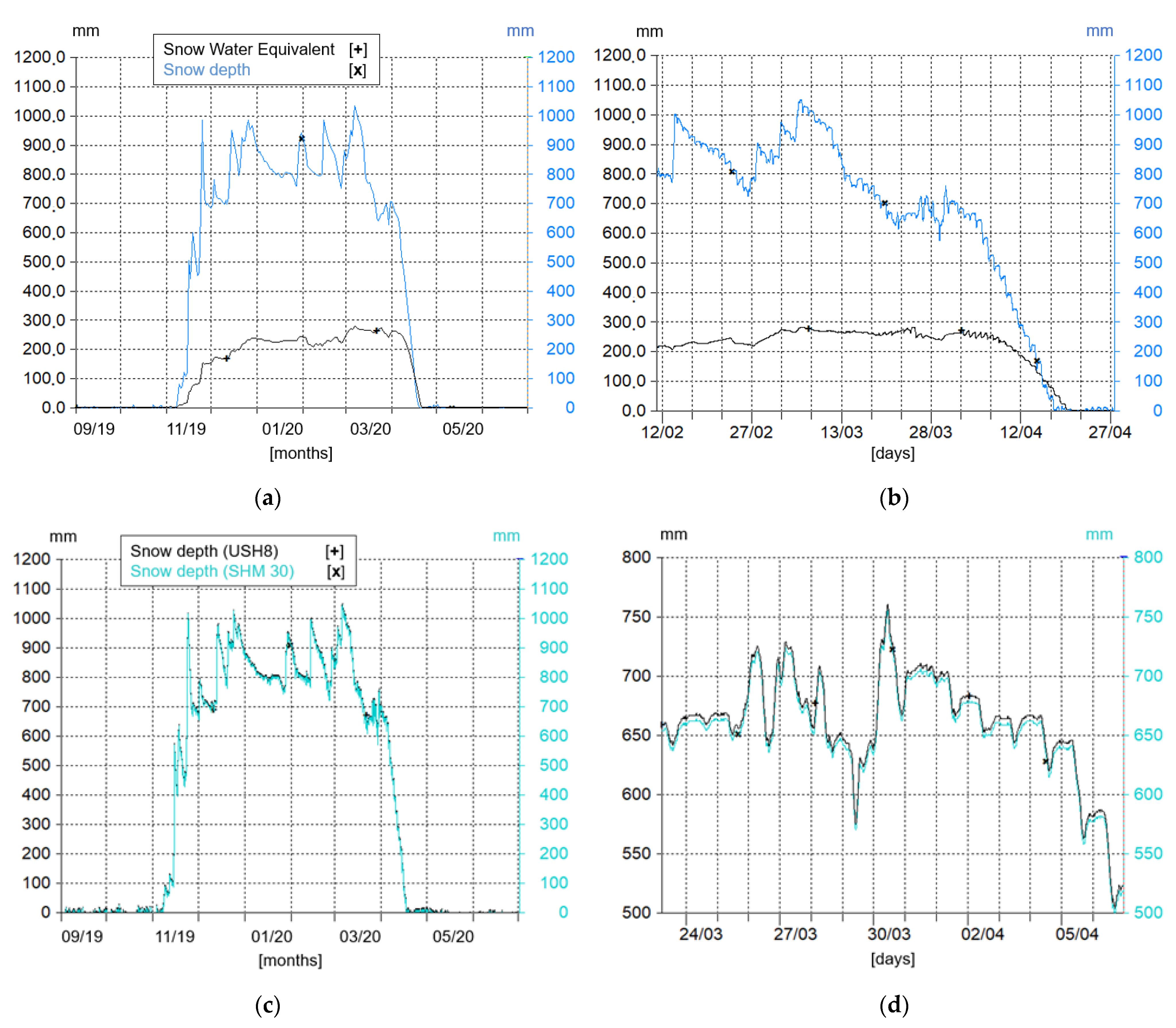
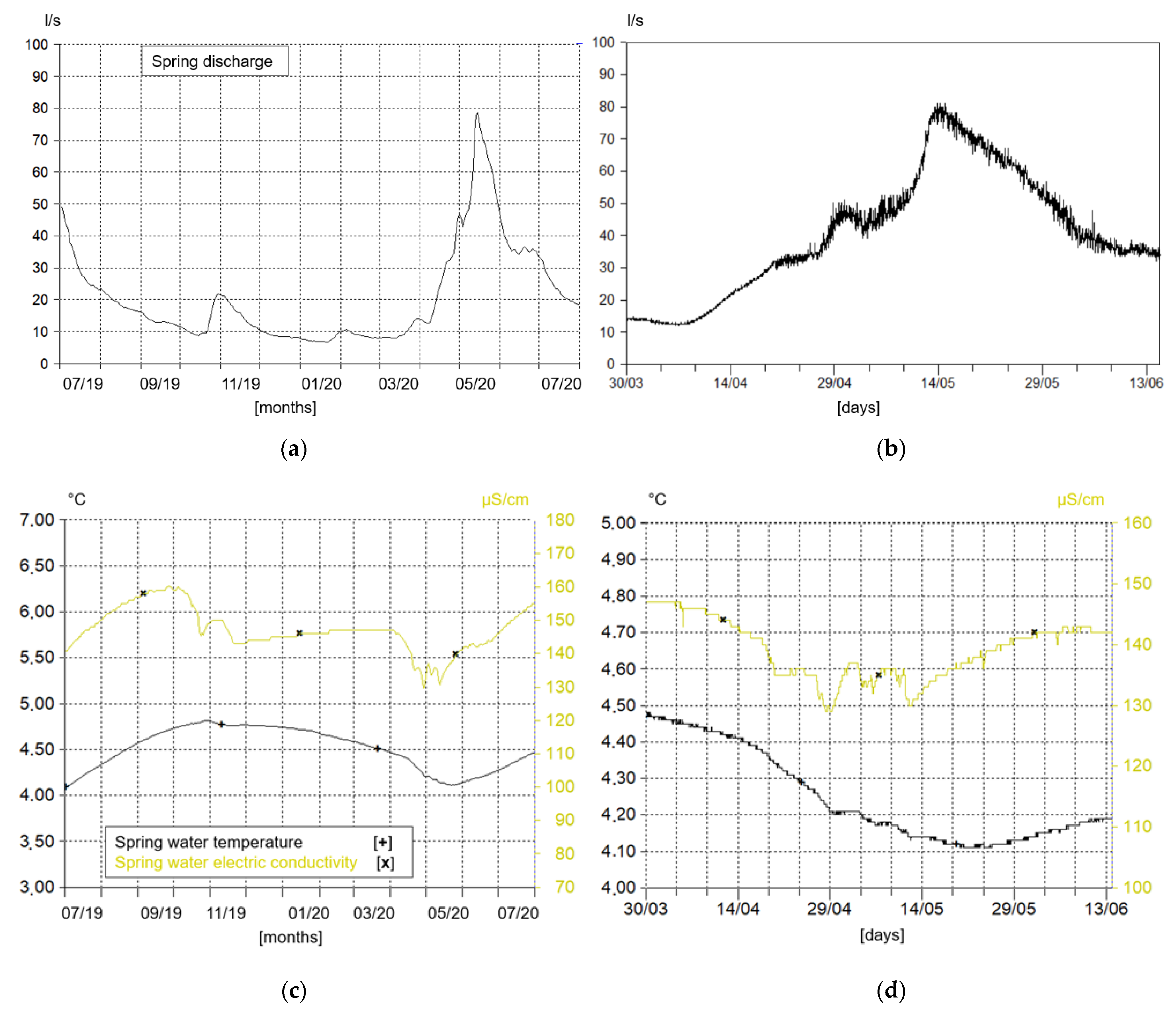
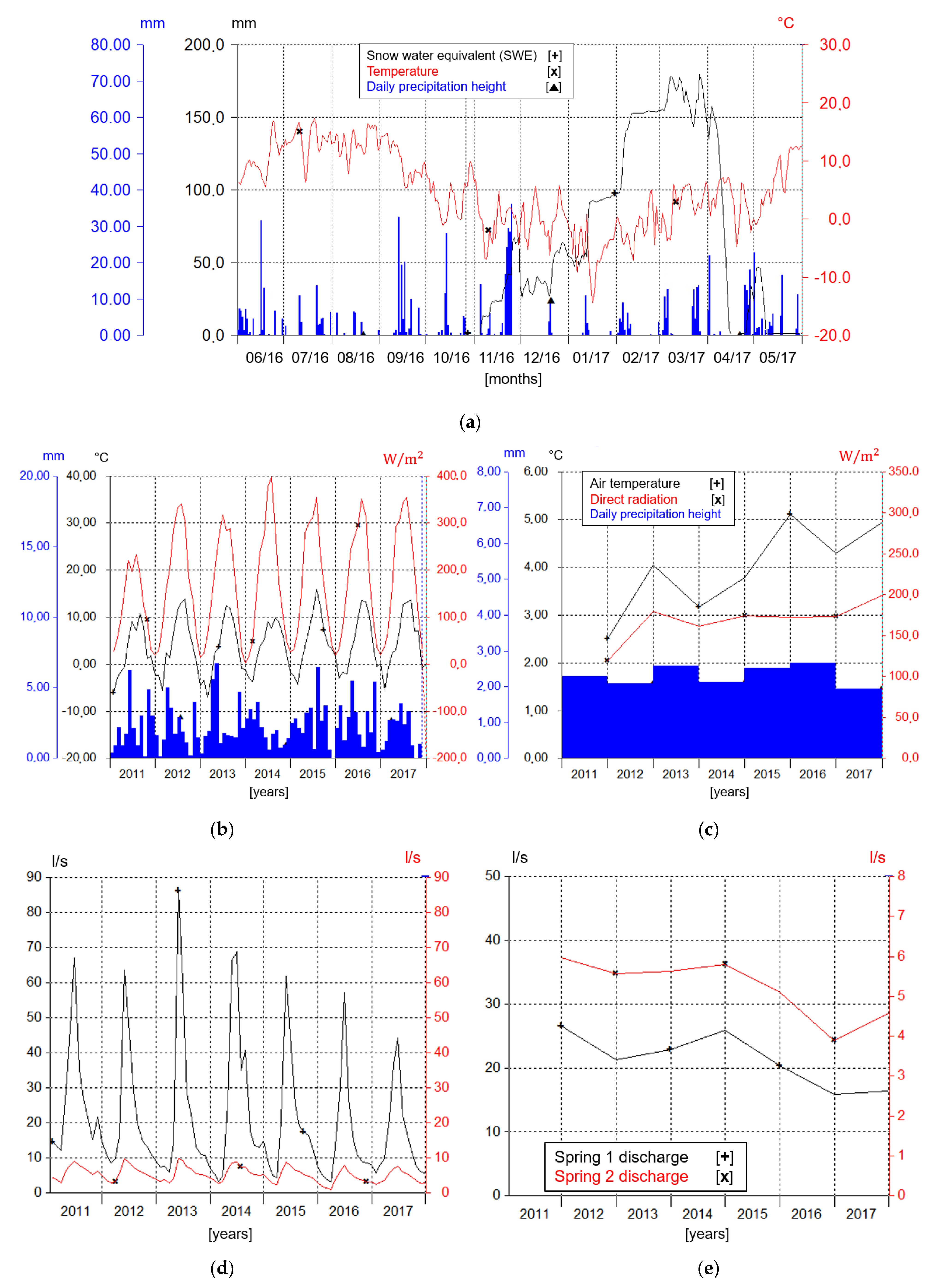
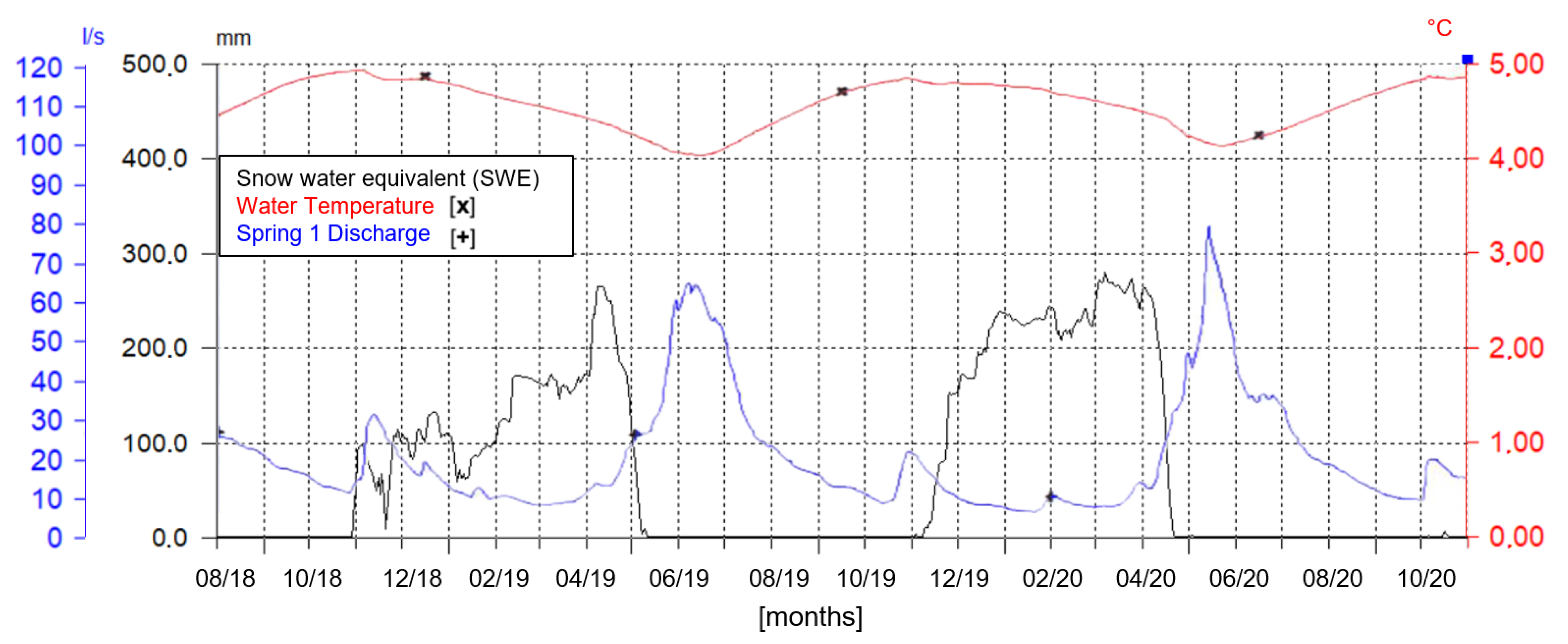
| Parameter | Sensor | Characteristics |
|---|---|---|
| Air temperature (°C) | hygrometer HygroClip2 (HC2-S3) (Rotronic AG, Bassersdorf, Switzerland) | range of application: −50 to 100 °C operating temperature: −50 to 100 °C housing:polycarbonate overall uncertainty: +/−0.1 °C |
| Air temperature (°C) | CWS All-In-One (AIO) Weather Sensor (Climatronics Corporation, New York, NY, USA) | range of application: −40 to 50°C operating temperature: −50 to 70°C overall uncertainty: +/−0.2°C |
| Relative humidity (%) | hygrometer HygroClip2 (HC2-S3) (Rotronic AG, Bassersdorf, Switzerland) | range of application: 0–100% RH operating temperature: −50 to 100 °C housing:polycarbonate overall uncertainty: +/−0.8% on measured value |
| Relative humidity (%) | CWS All-In-One (AIO) Weather Sensor (Climatronics Corporation, New York, NY, USA) | range of application: 0–100% RH operating temperature: −50 to 70°C overall uncertainty: +/−3% on measured value |
| Wind speed (m/s) | CWS All-In-One (AIO) Weather Sensor (Climatronics Corporation, New York, NY, USA) | range of application: 0–50 m/s operatingtemperature: −50 to 70 °C overall uncertainty: +/−0.1 m/s |
| Wind direction (°) | CWS All-In-One (AIO) Weather Sensor (Climatronics Corporation, New York, NY, USA) | range of application: 0 to 360° operating temperature: −50 to 70 °C overall uncertainty: +/−2° |
| Direct and inverse radiation (W/m²) | Albedometer model CMA6 (Kipp&Zonen, Delft, The Netherlands) | range of application: 0–2000 W/m² operating temperature: −40 to 80 °C overall uncertainty: +/−20 W/m² |
| Atmospheric pressure (hPa) | Barometric pressure sensor model 61302 (Young Co, Traverse City, MI, USA) | range of application: 500 to 1100 hPa operating temperature: −50 to 60 °C overall uncertainty: +/−0.2 hPa |
| Atmospheric pressure (hPa) | CWS All-In-One (AIO) Weather Sensor (Climatronics Corporation, New York, NY, USA) | range of application: 600 to 1100 hPa operating temperature: −50 to 70 °C overall uncertainty: +/−0.35 hPa |
| Rainfall (cumulate, mm; intensity, mm/h) | Pluviograph model PLUVIO2 OTT Hydromet, Kempten, Germany) | gathering area: 200 cm2 gathering volume: 1500 mm operating temperature: −40 to 60 °C resolution: +/−0.01 mm overall uncertainty: +/−0.1 mm |
| Rainfall/snow melting (mm) | Underground pluviograph model DQA030 (LSI Lastem, Settala, Italy) | gathering area: 324 cm2 operating temperature: 0 to 50 °C housing: Inox AISI304 resolution:+/−0.2 mm overall uncertainty: 0 to +/−1 mm/min |
| Parameter | Sensor | Characteristics |
|---|---|---|
| Snow water equivalent (mm) | Snow scale Snow pillow (Sommer GmbH & Co KG, Koblach, Austria) | range of application: 0 to 2500 mm operating temperature: > −30 °C material: fabric thickness PVC-foil resolution: 1 mm overall uncertainty: 0.25% +/− on measured value |
| Snow depth (mm) | Ultrasonic sensor USH-8 (Sommer GmbH & Co KG, Koblach, Austria) | range of application: 0 to 8000 mm operating temperature: −35 to 60 °C housing: aluminum resolution: +/−1 mm overall uncertainty: +/−0.10% on measured value |
| Snow depth (mm) | Laser sensor model SHM 30 (G. Lufft Mess-und Regeltechnik GmbH, Fellbach, Germany) | range of application: 0 to 10 m distance range: 0.1 to 30 m operating temperature: −40 to 50 °C resolution: +/−0.1 mm overall uncertainty: +/−5 mm |
| Parameter | Sensor | Characteristics |
|---|---|---|
| Water level (mm) | Multiparametric probe OTT CTD (OTT HydroMet GmbH, Kempten, Germany) | range of application: 0 to 4 m operating temperature: −40 °C to 85 °C resolution: +/−0.1 cm overall uncertainty: +/−0.05% FS |
| Water temperature (°C) | Multiparametric probe OTT CTD (OTT HydroMet GmbH, Kempten, Germany) | range of application: −25 to 70 °C operating temperature: −40 °C to 85 °C resolution: +/−0.01 °C overall uncertainty: +/−0.1 °C |
| Water electric conductivity (μS/cm) | Multiparametric OTT CTD (OTT HydroMet GmbH, Kempten, Germany) | range of application: 1 to 2000 μS/cm operating temperature: −40 °C to 85 °C resolution: +/−1 μS/cm overall uncertainty: 0.5 % on measured value |
Publisher’s Note: MDPI stays neutral with regard to jurisdictional claims in published maps and institutional affiliations. |
© 2022 by the authors. Licensee MDPI, Basel, Switzerland. This article is an open access article distributed under the terms and conditions of the Creative Commons Attribution (CC BY) license (https://creativecommons.org/licenses/by/4.0/).
Share and Cite
Mondani, M.; Gizzi, M.; Taddia, G. Role of Snowpack-Hydrometeorological Sensors for Hydrogeological System Comprehension inside an Alpine Closed-Basin. Sensors 2022, 22, 7130. https://doi.org/10.3390/s22197130
Mondani M, Gizzi M, Taddia G. Role of Snowpack-Hydrometeorological Sensors for Hydrogeological System Comprehension inside an Alpine Closed-Basin. Sensors. 2022; 22(19):7130. https://doi.org/10.3390/s22197130
Chicago/Turabian StyleMondani, Michele, Martina Gizzi, and Glenda Taddia. 2022. "Role of Snowpack-Hydrometeorological Sensors for Hydrogeological System Comprehension inside an Alpine Closed-Basin" Sensors 22, no. 19: 7130. https://doi.org/10.3390/s22197130
APA StyleMondani, M., Gizzi, M., & Taddia, G. (2022). Role of Snowpack-Hydrometeorological Sensors for Hydrogeological System Comprehension inside an Alpine Closed-Basin. Sensors, 22(19), 7130. https://doi.org/10.3390/s22197130







